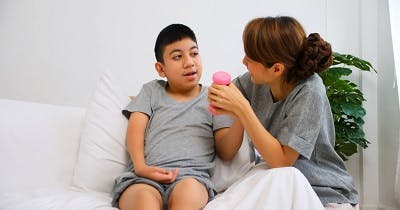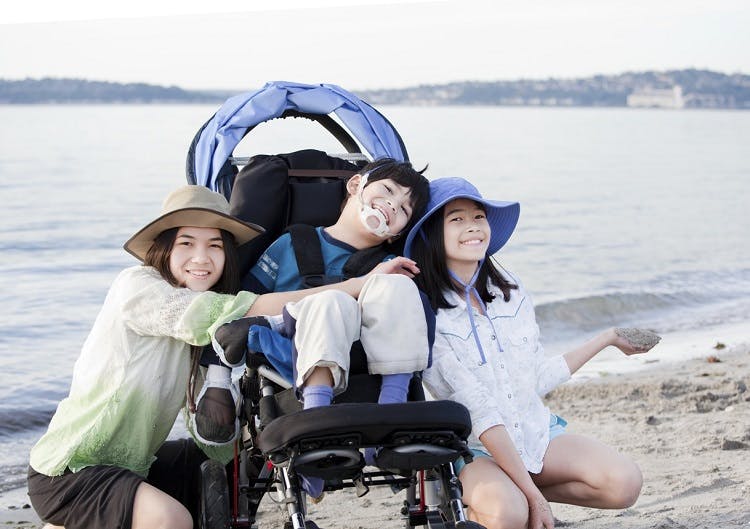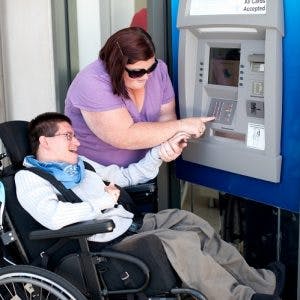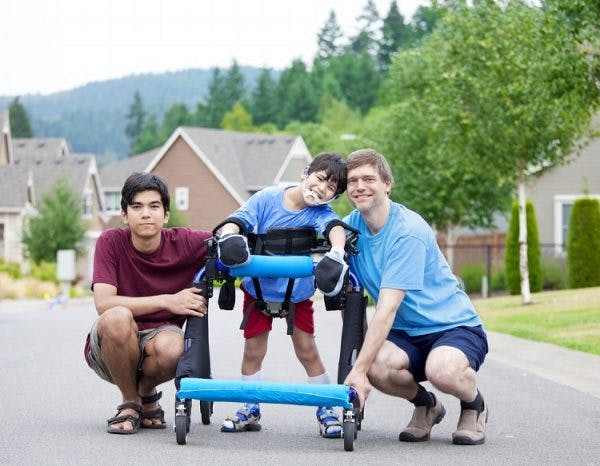Spastic quadriplegia is a type of cerebral palsy characterized by high muscle tone (spasticity) that affects the entire body. This may include the muscles of the mouth, which can affect an individual’s ability to speak, chew, and swallow.
Generally, individuals with spastic quadriplegia experience equal or greater motor impairments in their upper body than their lower body.
To help you better understand what spastic quadriplegia is, this article will explain:
- Causes of Spastic Quadriplegia
- Effects of Spastic Quadriplegia
- Is Spastic Quadriplegia Treatable?
- Management Interventions for Spastic CP
Causes of Spastic Quadriplegia
As with all forms of cerebral palsy, spastic quadriplegia is the result of damage to the developing brain before, during, or shortly after birth.
Spastic quadriplegia results from damage to the motor cortex, the region of the brain primarily responsible for controlling voluntary movements. Because it affects the entire body, this type of CP is generally associated with more severe brain damage.
One way to measure the severity of cerebral palsy is through the Gross Motor Function Classification System (GMFCS). It consists of 5 levels with level 1 being the mildest and level 5 the most severe.
This study found that out of 85 individuals with spastic quadriplegia, 20 were classified into GMFCS levels 1-3, which means that they were able to walk. In contrast, the other 65 were classified into levels 4 and 5, which indicates severely limited or the inability to walk.
While the majority of individuals with spastic quadriplegia may be unable to walk, many are still capable of functional activity. For example, individuals who are classified with a GMFCS level of 5 may be able to attain self-mobility by learning how to use a power wheelchair.
In the following section, we’ll explain the various effects of spastic quadriplegia and how it may affect one’s quality of life.
Effects of Spastic Quadriplegia

Because spastic quadriplegia results in motor impairments throughout the entire body, individuals may exhibit a wide range of complications.
Spastic quadriplegia is characterized by high muscle tone caused by the disrupted transmission of signals from the brain. While the brain damage that caused the cerebral palsy is nonprogressive, symptoms such as spasticity may worsen if not properly managed.
Moreover, spasticity is the underlying cause of many complications, including:
- Abnormal gait (walking pattern)
- Restricted movement
- Chronic pain
- Poor posture
- Disproportional growth/ musculoskeletal deformities
- Coordination and balance difficulties
- Speech impairments
- Joint subluxation/ -dislocation
- Poor quality sleep
- Feeding difficulties
- Inability to walk
These complications may significantly restrict motor control, which increases one’s risk of developing pressure sores, low muscle mass, and osteoporosis.
Additionally, because spastic quadriplegia is linked to greater amounts of damage to the brain, individuals are more likely to experience associative conditions. Associative conditions are the result of a completely different source of brain damage that commonly occurs along with cerebral palsy.
Associative conditions of cerebral palsy include:
- Epilepsy
- Hearing loss
- Vision impairments
- Intellectual disabilities
- Learning disabilities
Because these effects are not directly related to CP, many children with spastic quadriplegia may not experience them. However, being aware of this increased risk may help you identify symptoms sooner and prompt early management.
Now that you understand how spastic quadriplegia can affect one’s quality of life, let’s discuss the potential for recovery.
Is Spastic Quadriplegia Treatable?
While damage to the brain cannot be reversed, the central nervous system is capable of reorganizing itself through an adaptive phenomenon called neuroplasticity.
One of the most effective ways to promote neuroplasticity is through repetitive practice of task-specific functions. Consistently practicing a movement helps stimulate the brain and reinforces demand for that movement.
As a result, functions affected by brain damage may be reorganized to healthy, undamaged regions of the brain.
This research article suggests that “ninety percent of the gross motor maximal capacity of a child with cerebral palsy is reached by 5 years of age, and even earlier at 3.5 years for children with the most severe cerebral palsy.” Therefore, early intervention plays a significant role in promoting improvements.
However, the potential for improvement always exists because neuroplasticity never goes away.
Up next, we’ll discuss various management interventions that individuals with spastic quadriplegia may participate in.
Management of Spastic Quadriplegia

Because functional outcomes can significantly vary amongst individuals with spastic quadriplegia, a personalized approach to management is ideal.
Especially if individuals have severe motor impairments, participating in various management interventions is necessary to prevent the exacerbation of motor impairments.
Management for spastic quadriplegia can consist of:
- Physical therapy focuses on improving motor functions through targeted exercise.
- Occupational therapy focuses on improving an individual’s functional independence by practicing adaptable ways to perform everyday activities.
- Adaptive tools and mobility aids may help individuals perform functional tasks independently.
- Speech therapy focuses on helping individuals improve speech and communication skills. This involves activities to strengthen the oral motor muscles or teaching individuals how to use augmentative and alternative communication techniques.
- Feeding tubes help ensure adequate nutrition.
- Cognitive-behavioral therapy focuses on identifying problematic behaviors and teaching individuals more effective methods to demonstrate constructive thinking and actions.
- Electrical stimulation involves placing electrodes on the skin over the spastic muscle to induce passive contractions.
- Orthotics help ensure musculoskeletal alignment by preventing muscles from further contractions and providing a gentle stretch.
- Oral muscle relaxants like Baclofen can help manage global spasticity.
- Bisphosphonates are medications that slow down the rate of bone reabsorption caused by physical inactivity.
- Botox is a nerve blocker that is injected into spastic muscles to provide temporary spasticity relief.
- Standing frames support wheelchair-dependent individuals to stand, which may improve bone density, muscle mass, and circulation.
- Surgeries typically focus on managing spasticity and correcting skeletal alignment. Another common surgery involves implanting a baclofen pump under the skin near the abdomen to directly administer the muscle relaxant to the central nervous system.
Ultimately, managing spastic quadriplegia involves evaluating each individuals’ specific needs and targeting them through rehabilitative approaches.
Understanding Spastic Quadriplegia: Key Points
Spastic quadriplegia is a type of cerebral palsy that affects the entire body due to greater amounts of damage to the developing brain. As a result, individuals have an increased risk of experiencing additional conditions such as epilepsy and cognitive impairments.
However, not all cases of spastic quadriplegia are severe. Individuals may have mild symptoms and be able to ambulate. With the right management interventions, individuals with this type of CP may be able to prevent complications like spasticity from worsening and optimize their quality of life.
We hope this article helped you better understand what spastic quadriplegia is and how to manage it.











